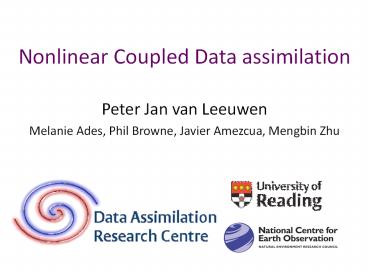Nonlinear Coupled Data assimilation - PowerPoint PPT Presentation
Title:
Nonlinear Coupled Data assimilation
Description:
Nonlinear Coupled Data assimilation Peter Jan van Leeuwen Melanie Ades, Phil Browne, Javier Amezcua, Mengbin Zhu The solution is a pdf! Bayes theorem: Data ... – PowerPoint PPT presentation
Number of Views:149
Avg rating:3.0/5.0
Title: Nonlinear Coupled Data assimilation
1
Nonlinear Coupled Data assimilation
- Peter Jan van Leeuwen
- Melanie Ades, Phil Browne, Javier Amezcua,
Mengbin Zhu
2
Data assimilation general formulation
Bayes theorem
The solution is a pdf!
3
Nonlinear filtering Particle filter
Use ensemble
with
the weights.
4
What are these weights?
- The weight is the normalised value of the
pdf of the observations given model state . - For Gaussian distributed variables is is given
by - One can just calculate this value
- That is all !!!
- Or is it? More is needed for high-dimensional
problems
5
Fully nonlinear DA Particle Filters
Degenerate
6
Particle Filters with resampling
Degenerate
7
Why doesnt this work?
Volume of a hypersphere with radius ry in an
Ny-dimensional space
Log10 of Volume of hypersphere of radius 1.
Number of observations
8
Reduce obs number via Localisation
Different particles perform Differently over the
domain. How do we glue different particles
together? Interesting work by Poterjoy.
Particle 17
Particle 3
Particle 7
9
Another solution proposal densities
Use a different model and correct in the weights
The second model knows about future observations !
10
Examples of proposed models
Use nudging or use LETKF or 4DVar
11
Note
These are all hybrids but this time without
ad-hoc adjustments. There is solid maths behind
all this!
12
Resulting weights
- The weights now contain contributions from
- the observations via the likelihood p(yx),
- The use of a different model than the original
- model (proposal density).
- So
13
Weight of a particle
Weight of Particle i
X
X
Position of particle i in state space
14
Optimal proposal density (1 timestep), implicit
PF (window)
This is a 4DVar on each particle, with a
perturbation added to it. But a special 4DVar
- no initial errors, - include model errors
(weak constraint) Weights proportional to
15
Example simple Gaussian modelSnyder et al 2008,
2011, 2015
Claim Number of particles needed to avoid
collapse grows exponentially with system size
16
Remedy
With ai found from
With wtarget given by
17
So, ensure that the weights are equal..
Target weight
Likelihood weight Proposal weight
18
Equal-weight Particle filtering
Define an implicit map as follows with
the mode of the optimal proposal density,
e.g. a random draw from the
density , with the
covariance of the optimal proposal
density, and chosen such that all
particles have equal weight (using the
expression for the weights).
19
Experiments, model error and observation errors
Gaussian, H linear
- Linear model of Snyder et al. 2008.
- 1000 dimensional independent Gaussian linear
model - 20 particles
- Observations every time step
20
Implicit Equal-weights Particle Filter1000
dimensional system, 20 particles
21
Note on localisation
- This particle filter has localisation build into
it because all updates are pre-multiplied by
either the model error covariance or a covariance
of the form - In which Q is the model error covariance and R
the observation error covariance. - NO EXPLICIT LOCALISATION NEEDED !!
22
ExampleHadCM3 climate model
- Coupled ocean-atmosphere climate model used
extensively in IPCC - 2.3 million variables
- No flux correction
- Atmosphere 3.75 X 2.5 staggered B, 19 levels
- Ocean 1.25 X 1.25 staggered B, 20
levels - Daily coupling
- Atmosphere run first with 30 min time step,
followed by ocean with 60 min time step
23
EMPIRE data-assimilation framework
Fast coupling of any model to data assimilation
codes via MPI, e.g. HadCM3 (2 million), Unified
Model (300 million), etc.
24
The model is nonlinear
Pdf of meridional wind at a point in the mid
North Atlantic.
25
Data-assimilation parameters
- Identical twin experiment
- 32 particles
- Daily observations of Sea-Surface Temperature
with uncertainty 0.55 K - Model errors smaller than 0.1 times deterministic
model update - Correlation structure from snapshots of long
model run.
26
Model error covariance
Correlation atmospheric zonal flow and oceanic
meridional flow
27
Results Observed variable SST
28
Results Ocean Temperature
29
Results Meridional velocity
30
Results Atmospheric Temperature
31
Rank Histograms
SST (observed)
Meridional wind high up in Atmosphere
(unobserved)
32
Time evolution of particles
Prior ensemble (yellow), posterior ensemble
(blue), truth (red), for SST in two grid points
33
Estimated pdfs
34
Conclusions
- Not only should particles be close to
observations, we have to move them such in state
space that their weights are equivalent. - We can use particle filters for climate models.
- Nonlinear filtering moves problem of state
covariances to covariances of model error - Efficient representation of pdf in
high-dimensional system is problematic.

